Gens Una Sumus!
Newsletter #930
August 15, 2020
By Abel Talamantez
Table of Contents
- Chess Clubs from Around the Country
- Fred and Pat Mayntz Memorial TNM
- Blitz Tournament of the Americas
- Online Events Recap
- Mechanics' Chess Social
- Weekly Classes
- Scholastic Online Offerings
- Online Events Schedule
- FM Paul Whitehead's Column
- GM Nick de Firmian's Column
- Submit your piece or feedback
Chess Clubs From Around the Country #1 Portland Chess Club

Portland Chess Club centennial logo
We revere that which stands the test of time, because its longevity reflects something unique and special that spans generations and survives challenges. When it comes to chess clubs, this is particualarly special because of the obstacles a brick-and-mortar chess club must overcome. Chess being what it is historically in the United States, a club is largely a volunteer effort to keep itself going, withstanding the challenges of rental space, player participation, and other elements that pose threats that many club leaders know all too well. Not many clubs in the United States have the privilege of owning their own building like the Mechanics' Institute in San Francisco and the Marshall Chess Club in New York. Even historic clubs like the Manhattan Chess Club, which was founded in 1877, closed in 2002 as they did not have the benefit of owning thier own space. There are those today looking to reopen this historic club, but it goes to show that even clubs with large histories will find time to be the greatest threat, as Delmore Schwartz writes, "..time is the fire in which we burn."
So in my first installment of Chess Clubs From Around the Country, I write about this amazing gem of a club, the Portland Chess Club. Founded in 1911 (before the Marshall Chess Club in 1915), this club has quietly promoted and represented chess in the Pacific Northwest for more than 100 years. While the club does not own their own space, they have been quite resourceful in maintaining the club.
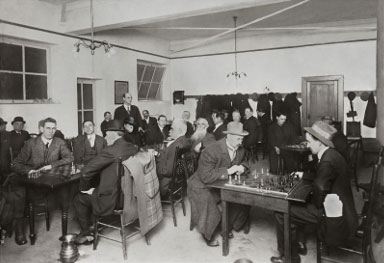
Portland Chess Club circa 1914
I spoke to chess club president Mike Janniro and Secretary/Treasurer Mike Morris (35-year member) about some of the history of the club. They said prior to their current location, the club was in a house in a residential neighborhood purchased by the club for the club. Because on tournament evenings players left late, many in the neighborhood complained, which led them to be stripped of their zoning and were forced to leave. After selling the house, they looked to find a new location.
Today the club meets on the third level of the Lloyd Center, which is a large shopping mall in downtown Portland. They sustain themselves with membership dues as well as from the genorosity of contributions in support of the club. The Lloyd center also shares a bit of Mechanics' Institute history, as Jude Acers conducted a simultaneous exhibition at the Lloyd Center in 1974 that set the world record for most games played (117).

Jude Acers at the Lloyd Center 1974
Portland has hosted many high profile chess fugures. World champions Jose Raul Capablanca, Alexander Alekhine, and Emmanuel Lasker have held simuls there, as well as Frank Marshall. At their centeenial celebration in 2011, GM Susan Polgar attended the festivities at the club.

GM Susan Polgar at the Portland Chess Club 2011
The club held some weekday events as well as an open recreational play evening on Friday nights. They also hosted tournaments on the weekend. The Portland Chess Club is the organizer of the annual Oregon Open over the Labor Day Weekend (which this year would have been their 70th). This year, the plan is to move that event online due to the COVID-19 concerns.
What I was surprised to learn is that the club has also been an organizer of some very high profile events, such as the 2002 National Elementary Championship with over 2000 players. Their annual Oregon Open offers a $10,000 guarantee and draws well over 100 players. Past winners of the Oregon Open include Arthur Dake, Yasser Seirawan, Peter Biyiasas, John Donaldson, and James Tarjan (Portland resident). Nick Raptis and Georgi Orlov have each won it 6 times. Full ist of winners here: http://www.nwchess.com/articles/history/OR_open_champions.htm
What I was happy to learn was that there was a great deal of cooperation between the other organizations and clubs in the Pacific Northwest. Players from Washington will travel to Portland to play at the club for a weekday or weekend event and the organzations all coordinate with each other in terms of scheduling so that both players and organizers benefit.
The club maintains a loyal, committed group that plays regularly, and they are looking to expand scholastic events and programming. For a club really looking to engage more players and create opportunities to thrive, a marriage of regular and scholastic events is essential. With all the challenges of todays climate, it was clear after speaking with both of them that they are always thinking of ways to keep the club active and strong, and thinking of ways to keep the club together for many years ahead.
When I spoke to Mike Morris, I lastly asked him if there were any good stories he would like to share. Mike has Mechanics' blood in him, having been to the Mechanics' Intitute many times when he worked in the Bay Area years ago. He shared a story of how William Addison, who later became the Chess Director at the Mechanics' Institute from 1980-1996, defeated Samuel Reshevsky in the 1st round of the U.S. Open in 1962. I thought it was fitting that when offered the opportunity to share a good story, he chose one that would have relevance to Mechanics' Institute. This spirit is part of what has made the Portland Chess Club endure.
Here is the game, annotations by GM Nick de Firmian.
(10) William G Addison - Samuel Reshevsky [E69]
US Championship New York, NY USA (1), 16.12.1962
 |
Bill Addison was one of the strongest players from the west and former MI Chess Director. Reshevsky was #2 in the US at this time. 1.d4 Nf6 2.c4 g6 3.g3 Bg7 4.Bg2 0-0 5.Nc3 d6 6.Nf3 Nbd7 7.0-0 e5 8.e4 c6 9.h3 This was trending opening theory of that time. Bronstein and others had popularized the King's Indian in the previous decade and players of the White side would try to control everything with the Fianchetto Variation. White's last move controls the important g4 square so a black knight can't cause trouble there. 9...exd4 10.Nxd4 Re8 11.Be3 a5 12.Qc2 Nc5 13.Rad1 White has move space while Black has potential for active piece play. 13...Nfd7 14.Nb3 Qe7 15.Nxc5 Nxc5 16.Qd2 The pressure on d6 gives White an edge. 16...Bf8 17.Rfe1 Be6
 |
18.Nd5! This tactic makes a small edge into a big edge. 18...cxd5 19.exd5 Ne4 [19...Bf5 20.Bxc5] 20.Bxe4 Bxh3 21.Bd4 material is back to even and the white pieces have taken powerful central posts. 21...Qc7 22.Qc3 [22.Qf4 Bg7 23.Bxg7 Kxg7 24.g4! may be even better] 22...Rac8 23.Bd3 a4 24.Rxe8 Rxe8 25.Re1 Rxe1+ 26.Qxe1 Qd7 27.b4 axb3 28.axb3 Qg4 29.Qe3?! [29.Bc3 Bg7 30.Qe8+ Bf8 31.Qe3 keeps a big edge as the white queen and bishop threaten a battary.] 29...Qd1+ now chances are equal 30.Kh2 Bg4 31.Be4 Bh6! 32.Qc3 Bd2 33.Qb2 h5?
 |
[33...f5 34.Bg2 f4] 34.Qa3! White comes around from the queenside to attack the black king! This unexpected direction wins the game. 34...Bh6 35.Qa8+ Bf8 36.Be3 Bf3 37.Bxf3 Qxf3 38.Kg1 h4 [38...Kg7 39.Bh6+ Kxh6 40.Qxf8+ Kh7 41.Qxd6 is an easily winning queen ending.] 39.Bh6 1-0
While the club is currently closed due to the public health crisis, they are transitioning some vents online to keep their members together. Here is the link to join their online chess community: https://www.chess.com/club/portland-chess-club
To learn more about the Portland Chess Club, please click to their homepage here: http://pdxchess.org/
Fred and Pat Mayntz TNM Report
The 3rd and 4th rounds of the Fred and Pat Mayntz Tuesday Night Marathons featured some separation at the top of the leaderboard and one big upset. We had special guest commentators NM Derek Wu and Tejas Mahesh joining FM Paul Whitehead and myself in the broadcast and both did an amazing job in helping call the games.
In the top section, FM Kyron Griffith and NM Ruiyang Yan stayed perfect with two wins and both are the only 4/4 scores going into next week. Griffith had the tougher evening, as he had to grind out a long win in round 4 against Theo Biyiasas, while Rui made quick work of Nitish Nathan. It seems we are headed for a big round 5 matchup between these two attacking players, and we look forward to the potential fireworks next week.
Jonah Busch provided the upset of the evening in defeating IM Elliott Winslow. Busch played a beautiful game and manged to hang on in a somehwat tricky endgame position to close the show. Congrats to him!
Pranav Sairam and Mansoor Mohammed remain lurking with 3.5/4. However, this is an eight-round tournament so there is still plenty of chess to be played!
In the lower section, Pranav Pradeep remains dominant, scoring another two wins and is now 4/4, a full point ahead of Rahim Dharssi.
Tune in next week for rounds 5 & 6 of the Tuesday Night Marathon, there should be a lot of action as players look to make moves toward the top of the leaderboard.
For full standings, click here: https://www.milibrary.org/chess-tournaments/fred-and-pat-mayntz-memorial-tuesday-night-marathon-online-aug-2020.
To watch the broadcast of rounds 3 & 4, click here: https://www.youtube.com/watch?v=N0pf2VJfF8E.
Here are some games from the evening, annotated by GM Nick de Firmian.
(1) IM Elliott Winslow (ecwinslow) (1930) - Jonah Busch (Kondsaga) (1693) [C06]
Live Chess Chess.com, 12.08.2020
1.e4 e6 2.d4 d5 3.Nd2 Nf6 4.e5 Nfd7 5.Bd3 c5 6.c3 Nc6 7.Ne2 cxd4 8.cxd4 f6 9.exf6 Qxf6 This recapture is less popular by over five to one, and probably with reason. Black will find some of the moves are fairly convoluted. [9...Nxf6 10.0-0 Bd6 11.Nf3 and there are thousands of games after all three of Black's moves, 11...0-0 (11...Qc7; 11...Qb6 usually played earlier) ] 10.Nf3 [10.0-0 Bd6 (10...Nxd4?! 11.Nxd4 Qxd4 12.Nf3 Qf6 13.Bg5 Qf7 14.Qc2 g6 (14...Bd6 15.Rac1 Qh5 16.Qxc8+ 1-0 (28) Rublevsky,S (2665)-Dyachkov,S (2510) Maikop 1998) 15.Rac1 Nc5 16.Ne5 Qg7 17.Bb5+ Bd7 18.Bxd7+ Nxd7 19.Qc8+ 1-0 (19) Raum,S (1879)-Veelders, W (1501) Verden/Aller 2009) 11.Nf3 is likely just a transposition.] 10...h6 Black could try to do without this move but it's not recommended. [10...Bd6 11.Bg5 Qf7 12.0-0 h6 13.Qb1! Nf8 14.Bh4 Bd7 15.b4! 1-0 (27) Svidler,P (2650)-Zarubin,P (2450) Azov 1996 CBM 056 Extra [Makarichev,S]] 11.0-0 Bd6
 |
12.Nc3? This natural move doesn't rise to the occasion. Black will put his house in order and solve his problems (development, especially the B/c8), without any new ones. [12.Ng3 is most popular, looking to gain more time attacking the queen at the right moment. 12...0-0 13.Bc2 (or even 13.Bb1!? so that after Qd3 and a defense, there is no ...Nb4 annoyance)) 13...Rd8 (13...Rf7 14.Nh5 Qd8 15.Re1 (15.Bg6 Re7 16.Bf4 Nf8 and Black pushes back) ) 14.Re1 is ready for 14...Nf8 15.Ne5 with some advantage (Black can't grab the pawn!); 12.Be3 0-0 13.Rc1 , given by Shaw in the excellent series on 1.e4, is at least as effective an anticipation; White keeps open possiblities of Qd2/Bf4 (if Black's rook moves laterally) or Bb5. 13...e5 14.Nc3! continues to pressure Black.] 12...0-0 13.a3 White is drifting. Either he never took this line seriously or forgot his analysis, or forgot *to* analyze. 13...Rd8 Amazingly Black's score in the big database is pushing 70% -- the sort of results a White player would long for! 14.Be3 Nf8 15.Re1 Bd7 Black is 4.5 out of 5 here! The bishop maneuver is reminiscent of the Stonewall Dutch -- and in fact of this line, working around the pawn chain. 16.Rc1 Rac8 17.b4 Be8 18.h3 Bg6 19.Bf1 Probably no longer a bishop worth spending time to save. 19...a6 20.Na4 Nd7 21.Nc5 Nxc5 22.bxc5 Bc7 [22...Bb8!?] 23.Qb3?! [Too late for 23.Bd3 Be4! although it does manage to reach an equal position after 24.Bxe4 dxe4 25.Nd2 Nxd4 26.Nxe4 Qe5 27.Ng3 Nf5 28.Bd2] 23...Na5 24.Qb2 Bh5 25.Ne5 Bxe5 26.dxe5 Qf7
 |
27.g4?! Seeds of suicide. Sooner or later it's going to be too loose on the kingside. 27...Bg6 28.f4 Be4 29.Rcd1 h5! 30.Qf2 Qg6 31.Qg3 hxg4 32.hxg4
 |
Now the players trade errors and the advantage back and forth. (White had about three minutes, Black still almost seventeen.) 32...Kf7?! [32...Nb3! remembers the queenside!] 33.Bg2 Rh8 34.Kf2? [34.Bf2! bears on e4, and keeps Black's rook out after 34...Bxg2 35.Qxg2 Rce8! Black also works with anticipation 36.f5 exf5 37.gxf5 Qxg2+ 38.Kxg2 Rh5 39.Rxd5 Rxf5 keeps it even.] 34...Bxg2? [34...Nc4 35.Bc1 Bxg2 looks in at c2 with big trouble.] 35.Kxg2? [35.f5! exf5 36.Qxg2! fxg4 (36...Qxg4?? 37.Qxd5+ actually leads to mate in a few moves!) 37.Kg1 seems, again, to come out okay (staying off of dangerous squares with the king). (37.Qxd5+ Qe6=) ] 35...Nc4? [35...Qe4+! first is the crusher. 36.Kf2 (36.Qf3? Rh2+) 36...Nc4 37.Bd4 Qc2+ 38.Kg1 Rh6 Black's attack with the h-file is decisive.] 36.f5? [36.Bf2 Qc2! is going to be no more or less than a draw after 37.f5] 36...exf5?! [36...Nxe3+! 37.Rxe3 Qg5 is veering towards Black: 38.Rb3 b5! (The only way) 39.cxb6? (39.Rc3 Ke7!) 39...Rc2+ 40.Kf3 (40.Kg1 Rh4 41.Rb4 Qh6 and mate is on the way) 40...exf5 41.b7 fxg4+ 42.Qxg4 Rf2+ and Black wins] 37.gxf5 [37.e6+ Qxe6 38.Bf2 stays balanced...] 37...Qxg3+ 38.Kxg3 Nxe3 39.Rxe3 Rxc5 40.Red3 Rd8 [40...Rh5 41.Rf3 d4 42.Kg4 Rh2 43.Re1] 41.Kf4 Rc4+ 42.Kg5 d4 43.e6+ Ke7 44.Kg6 Rd5 45.Rf1?! The computer still has it pegged on "0.00" (dead drawn) for quite a few moves now, but White is running out of time -- and used half of his last minute for this move. 45...Rcc5
 |
46.Kg5?! Down to 12 seconds! But inexplicably taking the pressure off the g7-pawn. Any rook move was still drawn. 46...Rc3 47.Rfd1 Rxd3 48.Rxd3 b5 49.Kg6! and again Stockfish thinks it's an unwavering draw. 49...a5 50.Kg5 b4 51.axb4 axb4 52.Kf4 [52.Kg6] 52...Kf6
 |
53.Ke4?? [53.Kg4! Rxf5 and now the only move would be 54.e7! Re5 55.Rxd4 b3 56.Rb4 and White's king is in front of the last pawn.] 53...Rxf5 Cut off! 54.Rxd4 [54.e7 Re5+ 55.Kxd4 (55.Kf4 Rxe7 56.Rxd4 g5+ 57.Kf3 Rb7) 55...Rxe7 wins.] 54...Re5+ 55.Kf4 Rb5 It's over, or would be if White had time to resign. 56.Re4 Ke7 57.Re2 b3 58.Rb2 Kxe6 59.Ke4 g5 60.Kf3 Kf5 61.Kg3 Rb4 62.Kf3 g4+ 63.Kg3 Kg5 64.Kh2 Kf4 65.Kg2 g3 66.Kf1 Kf3 67.Kg1 Ke3 68.Kg2 Kd3 69.Kxg3 Kc3 Kondsaga won by resignation. 0-1
(2) Patrick Liu (katechen77) (1620) - NM Ruiyang Yan (jij2018) (2149) [E07]
Live Chess Chess.com, 11.08.2020
1.c4 Nf6 2.g3 e6 3.Bg2 d5 4.Nc3 [4.Nf3 Be7 5.0-0 0-0 6.d4 is the most common sequence, when White keeps options with his undeveloped knight.] 4...Be7 5.Nf3 0-0 6.d4 c6 Black plays the solid line, all but ignoring the move order. [6...dxc4 7.Ne5 Nc6!? is a confounding line, when (7...Qd6!? heading for a6 is also interesting and played at the highest levels (think Kramnik!).) 8.Bxc6!? is the preferred way to go.] 7.0-0 Nbd7 8.c5?
 |
White caves at a bad time. Anything else was a solid plus for White! Now it's the other way around. [8.b3; 8.Qd3; 8.Qc2; 8.Nd2] 8...b6 9.b4 a5! The standard reaction, and White's chain dissolves. 10.cxb6 [10.b5!? puts up a fight, but the resulting passed c-pawn won't survive. 10...cxb5 11.c6 Nb8 12.c7 Qxc7 13.Nxb5 Qb7 14.Bf4 Bd7 15.Nd6] 10...axb4 11.Na4 Nxb6 12.Nxb6 Qxb6 Black is up a healthy pawn, and then some. White's weak a-pawn is under pressure, while Black's c-pawn can advance at will. 13.Bf4 Ba6 14.Qc2 Rfc8 15.Rfc1 c5 16.Qd1 c4
 |
Not much to say -- you can't do much more with an extra pawn than set it up like this! 17.Ne1 Bb5 18.Nc2 Ba4 19.Qd2 Bxc2 20.Qxc2 Qxd4 21.Be3 Qg4 22.Bf3 Qg6 23.Qd2 Ne4 24.Qc2 Nd6 25.Qd2 c3 26.Qd3 Qxd3 27.exd3 Nb5 Nothing wrong with this! [27...c2! is unstoppable, not wasting time winning a piece!] 28.Bd1 d4 29.Bf4 g5! 30.Be5 f6 31.Bg4 Ra6 32.Re1 fxe5 33.Rxe5 Nc7 [33...b3 34.Rxb5 b2 35.Rf1 Ba3 wins two rooks for two pawns.] 34.Rae1 Kg7 35.Bxe6 Nxe6 36.Rxe6 Rxe6 37.Rxe6 c2 38.Rxe7+ Kf6 39.Re1 c1Q 40.Rxc1 Rxc1+ 41.Kg2 Rc2 42.Kf3 Rxa2 43.Ke4 b3 44.Kxd4 b2 45.f4 gxf4 46.gxf4 b1R [46...b1Q was a lot faster.] 47.Kc4 Rxh2 48.d4 Rc2+ 49.Kd5 h5 50.Kd6 h4 51.d5 Rd1 52.Kd7 Rxd5+ 53.Ke8 Rc8# jij2018 won by checkmate 0-1
(3) FM Kyron Griffith (KyronGriffith) (2153) - Theo Biyiasas (TABiyiasas) (1906) [C47]
Live Chess Chess.com, 11.08.2020
1.e4 e5 2.Nf3 Nc6 3.Nc3 Nf6 4.d4 exd4 5.Nxd4 The Scotch Four Knights. Some might say it's not a serious attempt at an opening advantage, but the list of great players who have tried it is impressive. Perhaps they see it as a vacation from all the theoretical lines of the Ruy, or the tense maneuvering of the modern Giuoco Piano. 5...Bb4 6.Nxc6 bxc6 7.Bd3 d5 8.exd5 cxd5 9.0-0 0-0 10.Bg5 [10.h3 got a boost when Kramnik played it against Aronian, but the text is still preferred.] 10...Be6 [and here 10...c6 is almost 10 to 1 as frequent.] 11.Qf3 c5!? 12.Rad1
 |
One might ask where the other rook is going to be going to. 12...h6! [12...Re8? 13.Bb5! (suddenly winning!) was a couple of club players: 1-0 (27) Gisy,R (1589)-Mau,F (1289) Magdeburg 2006; 12...Bxc3 13.bxc3 h6 14.Bxf6 only move 14...Qxf6 15.Qxf6 gxf6 dries up the possibilities.] 13.Bxf6 Qxf6 14.Qxf6 gxf6 Black has the aggressive c and d pawn duo and the bishop pair. The doubled pawns on the kingside are not as big a factor. 15.a3 [15.Nb5] 15...Ba5 [15...Bxc3 16.bxc3 Rab8 is a slight advantage for Black] 16.Be2 Rfd8 17.Bf3 Bxc3 [17...Rab8!? 18.Nxd5 Rxb2] 18.bxc3 Rab8 19.Rb1 Rb6 [19...Kg7 20.Rfd1 Rxb1 21.Rxb1 Rd6] 20.Rxb6 axb6 21.Rb1 Rd6 It's too easy to let a rook become passive. [21...Rd7! 22.Rxb6 Ra7] 22.Kf1 Bf5 23.Rd1 Bxc2 24.Rxd5 Bd3+?! [24...Re6 25.Bg4 Re7 26.Rd6 Ra7 trades down and the ending is just a draw] 25.Ke1 now the white king is one step closer 25...Re6+ 26.Kd2 Bc4 27.Rd8+ Kg7 28.h4 [28.Bd5! is an advantage White can play on with.] 28...f5 29.Rd7 Kf6 [29...Bb5] 30.Bh5 [30.Bd5 Bxd5 31.Rxd5 h5 32.Kd3 Re4 33.Rd6+ Ke7 34.Rxb6 Rxh4] 30...Re4 31.Bf3 Re6 [31...Rxh4 32.Rd6+ Be6 33.Rxb6 Ra4] 32.g3 Ke5 33.Bh5 Rd6+ 34.Rxd6 Kxd6 35.Ke3 Ke5 36.Bf3 f6 37.Bb7
 |
White is nominally better but the game should just be a draw 37...Bb5?? Anywhere along the a2-g8 diagonal would hold. 38.Bc8?! [38.f4+! Kd6 39.Bc8! Bd7?! 40.Bxd7 Kxd7 41.Kd3 Kc6 42.Kc4 h5 43.a4 is a basic winning pawn ending; White gets to play Kb5, a5, take take and c4.] 38...Bf1?
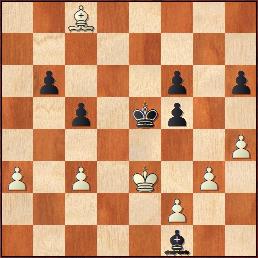 |
[38...f4+! 39.gxf4+ Kd5 might just hold.] 39.f4+! White has probably calculated this to the end. 39...Kd5 40.Bxf5 Kc4 41.Kf2! forcing a winning king and pawn ending 41...Bd3 42.Bxd3+ Kxd3 43.g4 Ke4 44.g5 [Simpler is 44.Kg3!] 44...fxg5 45.fxg5 hxg5 46.hxg5 Kf5 47.Kf3 Kxg5 48.Ke4 Kg4 49.c4 Kg5 50.a4 Kg4 51.Kd5 Kf4 52.Kc6 Ke4 53.Kxb6 Kd4 54.Kb5 Black resigned. Nice endgame play by Kyron. 1-0
(4) Pranav Pradeep (pranavpradeep2006) (1167) - Danny Cao (caodanny) (933) [B40]
Live Chess Chess.com, 12.08.2020
1.e4 c5 2.Nf3 e6 3.d4 cxd4 4.Nxd4 Nf6 5.Nc3 Nc6
 |
6.Nf3?! Quite the sideline -- the two moves that keep the edge sharp are [6.Ndb5; and 6.Nxc6] 6...Bb4 most common, hard to fault -- except for these moves that score better: [6...Bc5; 6...Qc7; 6...d6] 7.Bd3 d5 8.0-0!? Gets a bit tricky. 8...Bxc3 9.exd5! Nxd5 [9...Bxb2?! 10.Bxb2 Qxd5 11.Qe2 gives White good compensation for the pawn. (and 11.Qc1! is winning acc. to Stockfish: note that 11...0-0? gets crushed: 12.Bxf6 gxf6 13.Qh6 f5 14.Ng5) ] 10.bxc3 Nxc3 11.Qe1 Nd5 12.Bb5 [12.Ba3! Don't let that king get away!] 12...Bd7?! [12...0-0!] 13.Bb2 [13.Ba3!] 13...0-0 Black is ready for ...Qc7 and rooks to the center. 14.Bxc6?! White tries to conquer the dark squares, but ...f6 and ...e5 seals them up, meanwhile White will miss this bishop 14...Bxc6 15.Ne5?! [15.c4 gets the pawn back with Qe5, but Black will still stand better.] 15...Rc8 But now it's close to lost. 16.c4 Nf6?! [16...Nb6; 16...Ne7; 16...Nf4 are all more to the point.] 17.Qe3 a6 18.Qg3 b5? [18...Ne4! grabs the moment adn stop White setting up mating threats. Black would hold the advantage.] 19.Rad1 Qa5??
 |
[Black misses the lurking threats from White's dark-squared bishop. 19...Qe7 stays defended.] 20.Nxc6! [20.Nd7!] 20...Rxc6 21.Bxf6 g6 22.Qg5 The extra bishop and mating threats make for an easy conversion. 22...e5 23.c5! Re8 24.Rd6 Rxd6 25.cxd6 Qxa2 26.Qh6 pranavpradeep2006 won on time. 1-0
(7) Nitish Nathan (BreatheChessAlways) (1723) - Kritin Gopalakrishnan (chessboi2010) (1655) [A45]
Live Chess Chess.com, 12.08.2020
1.d4 Nf6 2.Bf4 g6 3.e3 Bg7 4.Nf3 The London System against the King's Indian. A solid (and now popular) choice by White. 4...0-0 5.Be2 d6 6.h3 just in time so that Black can't chase the bishop down starting with 6... Nh5. 6...c6 7.0-0 Bf5 8.c4 This makes sense here and is probably the best move. White could continue in classic "London" style with 8. Nbd2 followed by 9. c3 and 10. a4 but that is less aggressive. 8...h5 This doesn't help much 9.Nc3 Nbd7?
 |
This natural developing move is a mistake. Black needs to watch out in the center and 9...Ne4 was called for to exchange a piece and ease the spatial cramp. 10.Nh4! This simply wins the bishop for the knight and weakens the black pawn structure. White has a clear edge from the opening. 10...Be6?! [It's hard to give good advice here but the text just loses a pawn. Better would have been 10...Qa5] 11.d5 cxd5 12.cxd5 Bf5 13.Nxf5 gxf5 14.Bxh5 Qb6 15.Rb1 Rac8 16.Bf3 Nc5 17.Na4 Nxa4 18.Qxa4 Rc5 19.Rfd1 Ra5?! trying to get the pawn back on a2, but it doesn't succeed. 20.Qc4 Rc5 21.Qd3 Now White wins a second pawn and Black is lost. 21...Rfc8 22.Qxf5 e6 23.Qg5 exd5 24.Qg3 R8c6 25.Bh6 Ne8 26.Bxg7 Nxg7 27.h4 Qb5 28.h5 Kh7 29.b4! Strong play by White. Now the d5 pawn falls and the black position collapses. 29...Rc4 30.Bxd5 Nxh5 31.Qf3 Kg6 32.Bxf7+ Kh6 33.Rd5 Rc1+ 34.Rxc1 Rxc1+ 35.Kh2 Qf1 Threatening mate. If you could just move twice in a row.... 36.Qxh5+ Kg7 37.Qg6+ Kf8 38.Qg8+ Ke7 39.Qe8+ Kf6 40.Qe6+ Kg7 41.Rg5+ BreatheChessAlways won by resignation. The game may have continued... [41.Rg5+ Kh8 42.Qh3# #1/0 ] 1-0
(8) NM Tom Maser (Talenuf) (1556) - Kristian Clemens (kclemens) (1787) [C46]
Live Chess Chess.com, 12.08.2020
1.e4 e5 2.Nf3 Nf6 3.Nc3 Nc6 4.Bc4 Nxe4! Black makes use of the fork trick to immediately solve all his problems in the center. 5.Nxe4 d5 6.Bd3 dxe4 7.Bxe4 Bd7!? [7...Bd6 would be a natural continuation] 8.0-0 Bd6 9.Re1 0-0 10.c3 [10.Bxc6 Bxc6 11.Nxe5 Bxe5 12.Rxe5 Qd4 13.Re3 f5 would be compensation for the pawn] 10...Re8 11.Qc2 g6 12.d3 Kg7?! The black king is a little exposed here. 13.Bg5?! [13.Qd2! is a clever way to get the white queen over to the kingside] 13...f6 14.Bh4 Qc8 15.Nd2?! This is going backwards 15...f5 [15...g5! 16.Bg3 f5 17.Bxc6 Bxc6 is pleasant for Black] 16.Bd5 Ne7 17.Bb3 Nc6 18.Re2 Be6 19.Rae1 Bxb3 20.Qxb3 Qd7 21.Nc4 [21.Qxb7 Rab8 22.Qa6 Rxb2] 21...b6 22.Ne3 Be7 23.Bxe7 Rxe7 24.Nd5 Ree8 25.Nb4 Na5?! [25...Rad8 brings the rook to control the d-file] 26.Qd5! now White wins a pawn 26...Qxd5 27.Nxd5 Rad8 28.Nxc7?! [28.Rxe5 Rxe5 29.Rxe5 Nc6 30.Re6 Rxd5 31.Rxc6 Rxd3 32.Rxc7+ holds the extra pawn] 28...Re7 29.Nb5 Rxd3 30.f3 Nc6 Now material and position factors are level again. 31.Kf2 Kf6 32.Na3 Na5 33.Re3 Rxe3 34.Rxe3 Rd7 35.Ke2 h5 36.h4?! White could maintain the balance by immediately offering the rook trade with 36. Rd3 36...Nb7! 37.Rd3 Rxd3 38.Kxd3 Nc5+ 39.Kc4 e4?! [39...g5! 40.hxg5+ Kxg5 would get the black king into play quickly with decisive effect] 40.b4? [40.fxe4!] 40...exf3! 41.gxf3 Nd7?! [41...Ne6 42.Nb5 a6 43.Nd6 g5! gets the powerful passed h-pawn] 42.Kd5? Ne5! The knight jumps in with decisive effect to chase the white pawns. White needed to prevent this on the previous move with 42. f4! 43.f4 Nd3 44.Nb5 a6 45.Nc7 Nxf4+ 46.Kc6 Ne2 [46...g5!] 47.Nd5+ Ke5 48.c4
 |
48...b5! This pawn, which seemed doomed on b6, suddenly influences the battle with great effect. 49. c5? Nd4+ would win the white knight. 49.Ne7 bxc4 50.Nxg6+ Kf6 51.Nf8 c3 the black c and f pawns are too much for the white knight 52.Nd7+ Ke7 53.Nc5 c2 54.Nd3 f4 55.a4 f3 56.b5 axb5 57.axb5 f2 58.Nxf2 c1Q+ 59.Kb7 Nd4 0-1
(9) NM Michael Walder (FlightsOfFancy) (1745) - Kevin Joe Roberts (KeRtheBarbarian) (1675) [C64]
Live Chess Chess.com, 11.08.2020
1.e4 e5 2.Nf3 Nc6 3.Bb5 Bc5 4.c3 Qf6?!
 |
5.d4! exd4 6.e5! This excellent, aggressive opening play by White highlights the drawback of Black's early queen move. Now the black pieces get pushed around by the white pawns, 6...Qg6 [6...Nxe5? 7.Qe2 wins a piece] 7.cxd4 Bb4+ 8.Nc3 Nge7 [8...Qxg2 9.Rg1 Qh3 10.d5 would be a terrible for Black] 9.0-0 0-0? [Black needed to get at least some hold of the center with 9...d5] 10.d5 Nd8 11.Bd3 Qh5 12.Qb3 [12.Ne2! would really make the black queen feel uncomfortable] 12...Bxc3 13.bxc3 b6 14.Re1 Bb7 15.c4 A model position for White. The advanced pawn center severerly restricts the black pieces. White has space and the bishop pair to boot. 15...Ng6 16.Bb2 Nf4 17.Bf1 c6 18.Rad1 cxd5 19.cxd5 Rc8 [19...Qg4 20.Kh1 doesn't help] 20.Rd4! Ng6 21.g4 Black resigned. He could play on with 21...Qh6 but had enough of this miserable position. 1-0
The Blitz Tournament of the Americas Today August 15th!



The big tournament of titled players, which at this writing includes nine GM's among the more than 100 tentative participants across the Americas, is set for Saturday, August 15. The action will be carried by Chess.com on their channel as they will be re-streaming our broadcast! This event will start at 3:00pm Pacific and is 9SS G/3 +2. To watch, tune in to our Twitch channel here: https://www.twitch.tv/mechanicschess.
To see the current player list, click here: https://www.milibrary.org/chess-tournaments/blitz-tournament-americas
The event is organized by the Mechanics' Institute, in partnership with KmadaChess and Chess Sin Fronteras. Our mission was to bring the diverse communities of the Americas and beyond together for positive social engagement through chess. We all look forward to showcasing the talent, generosity and competitve spirit of all the players in this completely free, fun event. Tune in next week for cpomplete results!
Mechanics' Online Events Recap
Friday Night Blitz August 7: Winner: IM Elliott Winslow (ecwinslow)
https://www.chess.com/tournament/live/mechanics-friday-night-online--1429411
Saturday Night Blitz: Winner August 8: Winner: Kunal Shrivastav (king_kunal)
https://www.chess.com/tournament/live/mechanics-saturday-night-blitz--1494823
Sunday Evening Blitz: August 9: Winner: Javier Silva (J3Chess24)
https://www.chess.com/tournament/live/mechanics-sunday-night-blitz-1493269
Mechanics' Institute Regular Online Classes
Monday 6:30-8PM - Endgame Lab by FM Paul Whitehead
More information: https://www.milibrary.org/chess/endgame-lab-fm-paul-whitehead
Register at: https://mechanics-institute.jumbula.com/2020OnlineClasses_120/EndgameLabbyFMPaulWhitehead
Wednesday 6:30-8PM - Online class with FM Paul Whitehead
More information: https://www.milibrary.org/chess/online-class-fm-paul-whitehead
Register at: https://mechanics-institute.jumbula.com/2020OnlineClasses_120/OnlineClasswithFMPaulWhitehead
Thursday 6:30-8PM - Online class with GM Nick de Firmian
More information: https://www.milibrary.org/chess/online-class-gm-nick-de-firmian
Register at: https://mechanics-institute.jumbula.com/2020OnlineClasses_120/OnlineClasswithGMNickdeFirmian
Mechanics' Chess - Scholastic Offerings
Free daily non-rated tournaments on chesskid.com:
https://www.milibrary.org/chess-tournaments/scholastic-online-tournaments-every-day-chesskidcom
Saturday, August 15: starts at 3:00PM - join from 2:45PM
6SS G/10 +2 USCF rated: https://www.milibrary.org/chess-tournaments/uscf-online-rated-scholastic-tournaments-chesskidcom
Sunday, August 16: starts at 4:00PM - join from 3:45PM
5SS G/5+5 : https://www.chesskid.com/play/fastchess#t=89128
Monday, August 17: starts at 4:00PM - join from 3:45PM
4SS G/15+0: https://www.chesskid.com/play/fastchess#t=88837
Tuesday, August 18: starts at 4:15PM - join from 4PM
5SS G/5+5: https://www.chesskid.com/play/fastchess#t=88838
Wednesday, August 19: starts at 4PM - join from 3:45PM
4SS G/20+0: https://www.chesskid.com/play/fastchess#t=88839
Thursday, August 20: starts at 4PM - join from 3:45PM
5SS G/5+5: https://www.chesskid.com/play/fastchess#t=88840
Friday, August 21: starts at 4PM - join from 3:45PM
5SS G/10+5: https://www.chesskid.com/play/fastchess#t=88841
If you have any problems connecting with us on chesskid.com, please send us an email and we'll send you step-by-step instructions with pictures.
Games from Scholastic Tournaments
Annotations by GM Nick de Firmian
(5) LightIris (1293) - Nightimeninja (1305) [C20]
Live Chess ChessKid.com
1.e4 e5 2.Qh5 This is trying for the four move checkmate, but getting the queeb out so early is against the opening principles, 2...Nc6 3.Bc4 g6 4.Qf3 Nf6 Preventing again the threatened Qxf7 mate and developing a piece. This is good, but Black could really take advantage of the white queen being out with [4...f5! 5.exf5 Nd4 6.Qd5 Qe7
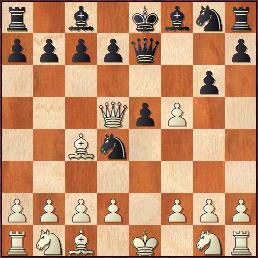 |
 |
(6) zzng (1384) - SafeRelaxedKite (1319) [C50]
Live Chess ChessKid.com
1.e4 e5 2.Nf3 Nc6 3.Bc4 Bc5 4.Nc3 A safe and sensible developing move, but masters prefer to use the pawns with 4. c3 or 4. d3 4...Nf6 5.d3 d6 6.h3 h6 7.Be3 Bb6 Both sides have played logically to bring the pieces out. 8.Nd5 Nxd5 9.Bxd5 Bd7 10.0-0 0-0 11.a3 a6?! copying White's move, but this allows the pawns to get wrecked. 12.Bxb6 cxb6 13.c4?! [13.c3 would leave the bishop on d5 with a retreating diagonal] 13...Re8 14.Re1 Rb8 15.Nh2 Qg5 16.Qf3
 |
NEW: US Chess Online Rated Tournaments
Twice a month
August 16, 23, 30 @ 3PM on chesskid.com
https://www.milibrary.org/chess-tournaments/uscf-online-rated-scholastic-tournaments-chesskidcom
US Chess online rated - affecting online rapid rating - every player must be a US Chess member
Trophies or Medals for Top Finishers
Convenient, safe platform & tight fair play screening
Space is limited to first 30 players to ensure tournament quality
Continuing our Small Group Afternoon Chess Classes
More information: https://www.milibrary.org/chess/scholastic-chess#online%20classes
1-hour intensive class followed by optional online tournament
$25/class, $45/two classes or $80/four classes package
Available classes:
Monday 4:00-5:00PM - Coach Colin
Tuesday 3:15-4:15PM - Coach Andy
Friday 2:00-3:00PM - Coach Andy
If you have any questions, or need a sample of a class, please feel free to reach out to [email protected].
Mechanics' Institute Online Events Schedule
The Mechanics' Institute Chess Club will continue to hold regular online events in various forms. Here is the upcoming schedule for players:
Format: 5SS G/8+2
Join from 6PM - https://www.chess.com/live#t=1508900
Start at 7PM
Past Club Tournament results are here:
Any questions? [email protected]
FM Paul Whitehead
The King March: Walk of Shame, Part 1.
Enough with these victorious king marches from the last two weeks, it’s time to get down to the fun stuff: the walk of shame.
In these drastic examples, the king is rudely awoken up from his slumbers with a pail of ice-cold water, then quickly frog-marched to the guillotine under heavily armed guard.
There’s no reprieve for His Royal Highness in these brutal and nasty games, and his fate is to die far from home.
It’s hard to feel sorry for him though, as it’s quite often his own conceit and carelessness that lands him in trouble.
Off with his head!
---------------------------------------------------------------------------------------------------------------------
In our 1st example white tries to land a blow, but black is one step ahead:
Morgan-Shipley 1891
1.e4 e5 2.Nc3 Nc6 3.f4 exf4 4.d4 Qh4+ 5.Ke2 d5 6.exd5 Bg4+ 7.Nf3 O-O-O 8.dxc6 Bc5 9.cxb7+ Kb8 10.Nb5 Nf6 11.c3 Rhe8+ 12.Kd3 Bf5+ 13.Kc4 Be6+ 14.Kxc5.

14… a5 15.Nxc7 Qh5+ 16.Ne5 Nd7+ 17.Kb5 Qxd1 18.Bxf4 Qxa1 19.Ka6 Nxe5 20.Nxe8 Rd5 21.Bc4 Qxh1 22.Bxd5 Qf1+ 23.Kb6 Qxf4 24.Bxe6 fxe6.
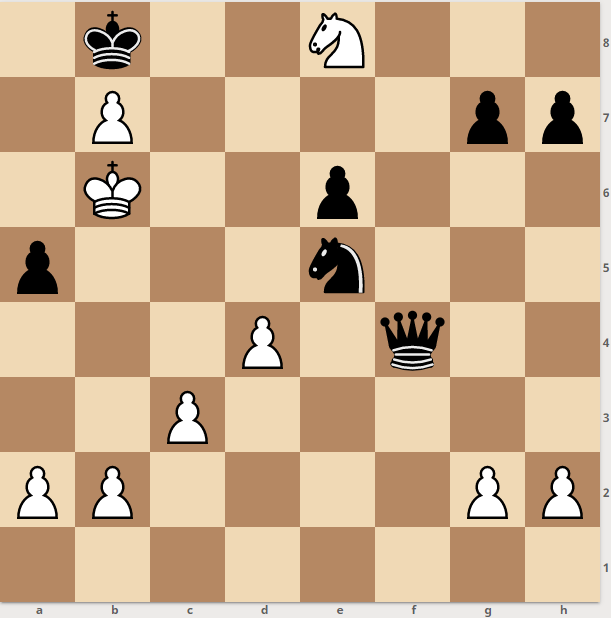
White resigned.
---------------------------------------------------------------------------------------------------------------------
Paul Morphy shows us how it’s done:
Schulten-Morphy 1857
1. e4 e5 2. f4 d5 3. exd5 e4 4. Nc3 Nf6 5. d3 Bb4 6. Bd2 e3 7. Bxe3 O-O 8. Bd2 Bxc3 9. bxc3 Re8+ 10. Be2 Bg4 11. c4 c6 12. dxc6 Nxc6 13. Kf1 Rxe2 14. Nxe2 Nd4 15. Qb1 Bxe2+ 16.Kf2.
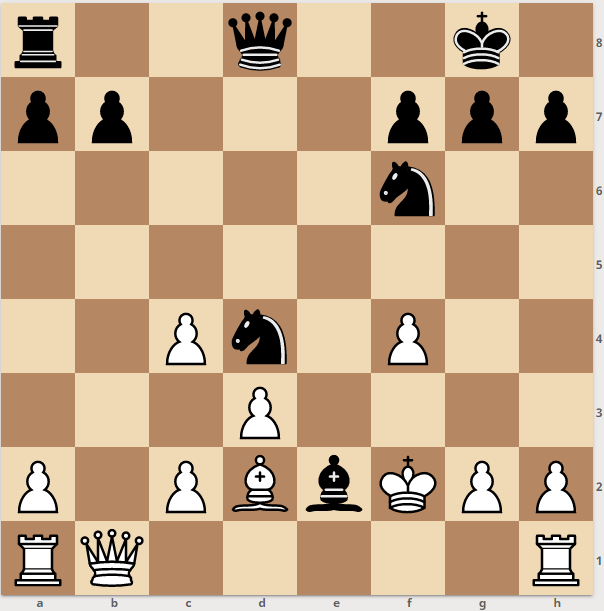
16… Ng4+ 17. Kg1 Nf3+ 18. gxf3 Qd4+ 19. Kg2 Qf2+ 20. Kh3 Qxf3+ 21. Kh4 Nh6 22. Qg1 Nf5+ 23. Kg5 Qh5.

Checkmate.
---------------------------------------------------------------------------------------------------------------------
A beautiful sustained mating attack, featuring numerous sacrifices:
van Foreest-Benima 1885
1.e4 e5 2.f4 exf4 3.Nf3 g5 4.Bc4 g4 5.O-O gxf3 6.Bxf7+ Kxf7 7.Qxf3 Bc5+ 8.Kh1 Nf6 9.e5 d6 10.exf6 Bf5 11.d4 Bb6 12.Qxf4 Bxc2 13.Nc3 c6 14.Qf2 Bd3 15.Qg3 Bg6 16.Ne4 Bxe4 17.Qg7+ Ke6 18.f7 Rf8 19.Qg4+ Kd5.
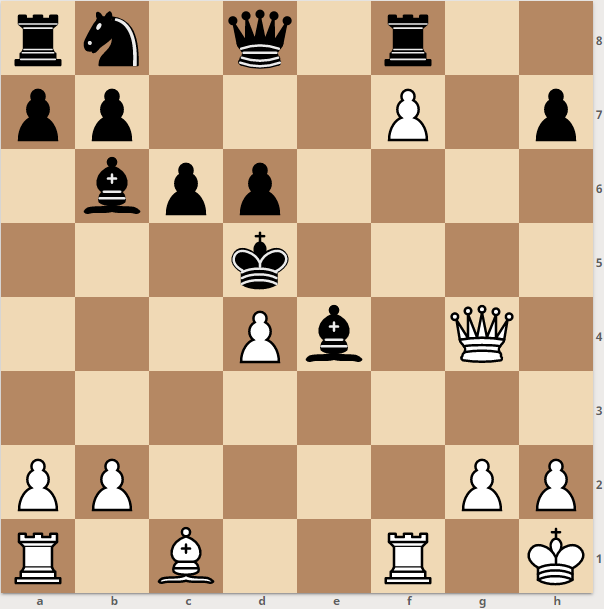
20.Rf5+ Bxf5 21.Qxf5+ Kxd4 22.Be3+ Kxe3 23.Qf3+ Kd4 24.Qf4+ Kd5 25.Qf5+ Kd4 26.Rd1+ Kc4 27.Qe4+ Kb5 28.Qd3+ Kb4 29.a3+ Ka5 30.Qc3+ Ka6 31.Qc4+ Ka5 32.b4+ Ka4 33.b5+ Ka5 34.Qb4.

Checkmate.
---------------------------------------------------------------------------------------------------------------------
The 12-year-old Garry Kasparov takes a GM scalp with this queen-less middlegame king hunt:
Romanishin-Kasparov 1975
1.f4 d5 2.Nf3 Nf6 3.e3 Bg4 4.b3 Nbd7 5.Bb2 c6 6.Be2 Qc7 7.O-O Bxf3 8.Bxf3 e5 9.d3 Bd6 10.g3 O-O-O 11.c4 dxc4 12.bxc4 h5 13.Qc2 h4 14.Nc3 hxg3 15.hxg3 exf4 16.exf4 g5 17.Ne4 Nxe4 18.dxe4 Rhg8 19.e5 Bc5+ 20.Kg2 gxf4 21.g4 Nxe5 22.Qf5+ Qd7 23.Qxd7+ Nxd7 24.Kh3 Nb6 25.Bf6 Rd3 26.Rac1 Nd7 27.Ba1 f5 28.Kh4.

28…Be7+ 29.Kh5 Rg5+ 30.Kh6 Rd6+ 31.Kh7 Nf8+ 32.Kh8 Rh6.
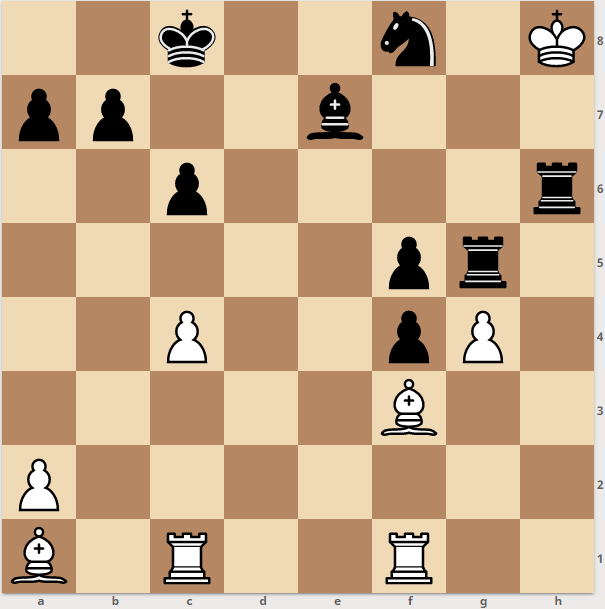
Checkmate.
---------------------------------------------------------------------------------------------------------------------
What a beautiful move 17…Ng3+ is! Another crushing attack ending in mate.
King-Maguire 1896
1.e4 e5 2.Nf3 Nf6 3.d4 exd4 4.e5 Ne4 5.Qe2 Bb4+ 6.Kd1 d5 7.exd6 f5 8.dxc7 Qxc7 9.Nxd4 Nc6 10.Be3 Bd7 11.c3 Nxd4 12.Bxd4 Ba4+ 13.Ke1 O-O-O 14.Qd3 Rxd4 15.Qxd4 Rd8 16.Qxb4 Rd1+ 17.Ke2.

17… Ng3+ 18.fxg3 Qe5+ 19.Kf2 Qe1+ 20.Kf3 Bc6+ 21.Kf4 Qf2+ 22.Kg5 Qe3+ 23.Qf4 Qe7+ 24.Kxf5 Bd7.
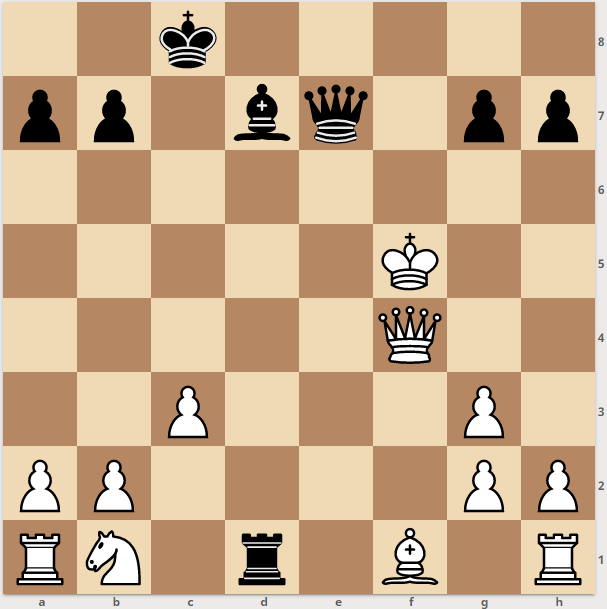
Checkmate.
---------------------------------------------------------------------------------------------------------------------
14…Ba6! cutting off squares for white’s king is very nice. In a scenario not often seen, the black king delivers the final move- and its mate!
Smitten-Dadian 1896
1. e4 e5 2. f4 exf4 3. Nf3 g5 4. Bc4 g4 5. Ne5 Qh4+ 6. Kf1 d5 7. Bxd5 Nf6 8. Bxf7+ Kd8 9. d4 Nc6 10. Nxc6+ bxc6 11. Nc3 f3 12. g3 Qh3+ 13. Kf2 Qg2+ 14. Ke3 Ba6 15. Kf4.
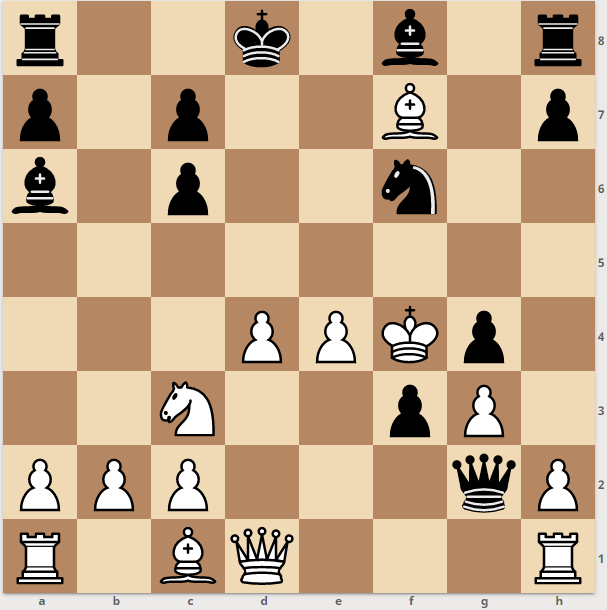
15… Bh6+ 16. Kf5 Qh3 17. Kxf6 Rf8 18. e5 Rxf7+ 19. Kxf7 Qh5+ 20. Kf6 Bg7+ 21. Kxg7 Qg6+ 22. Kf8 Kd7.
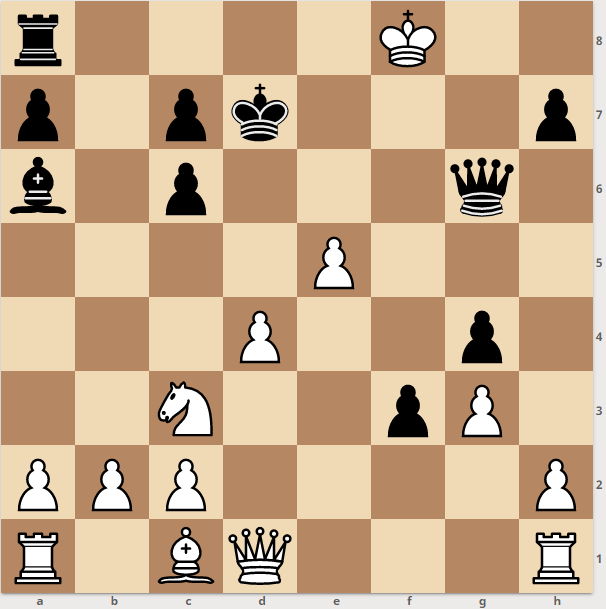
Checkmate.
---------------------------------------------------------------------------------------------------------------------
A wonderful game with some sparkling moves. 9.Nxe5! was nice, and black should have declined the offer. 14.Rxd1! and 16.0-0! underscored black’s helplessness. The final position, with the dead black king occupying the opposing monarch’s throne, is quite hilarious!
Vucinic-Djurovic 1984
1. e4 Nf6 2. Nc3 d5 3. exd5 Nxd5 4. Bc4 Nb6 5. Bb3 Nc6 6. Nf3 e5 7. d3 Bg4 8. h3 Bh5 9. Nxe5 Bxd1 10. Bxf7+ Ke7 11. Bg5+ Kd6 12. Ne4+ Kxe5.
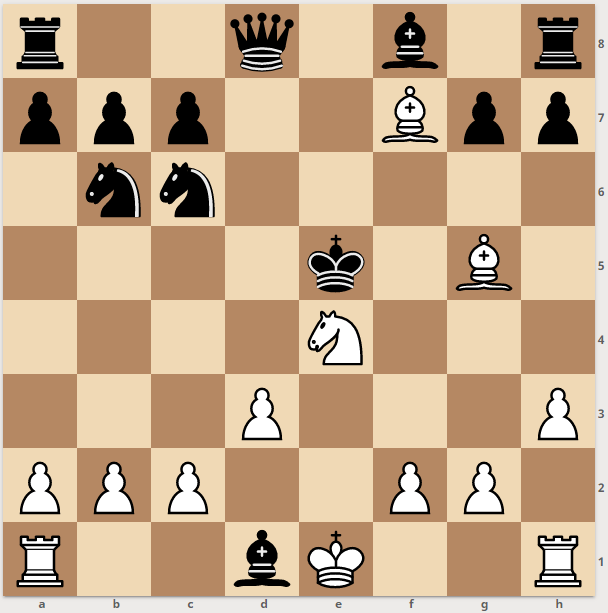
13. f4+ Kd4 14. Rxd1 Qxg5 15. c3+ Ke3 16. O-O Qh4 17. Rf3+ Ke2 18. Rd2+ Ke1 19. Rf1.
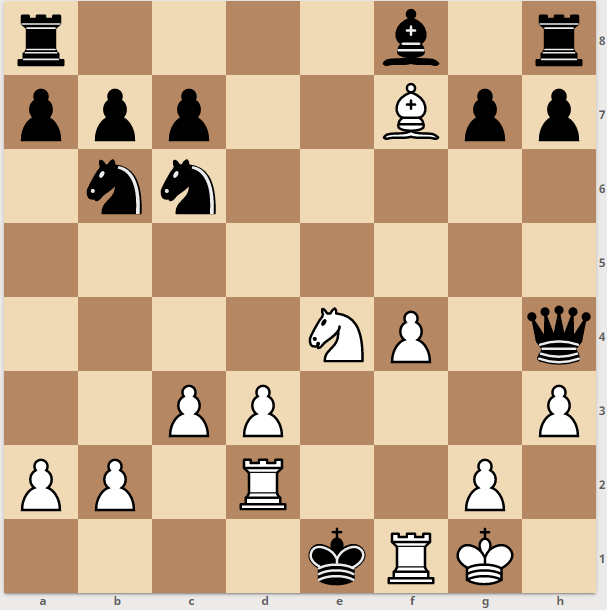
Checkmate.
---------------------------------------------------------------------------------------------------------------------
In this late middlegame attack black’s king is run straight up the board in just a handful of moves. The only rest he finds is in a grave white has dug for him, far from home.
Pogonina-Gunina 2012
1. e4 c6 2. d4 d5 3. e5 Bf5 4. Nf3 e6 5. Be2 Ne7 6. O-O h6 7. Nbd2 Bg6 8. Nb3 Nf5 9. a4 Nd7 10. a5 a6 11. c4 Be7 12. cxd5 13. Bd3 O-O 14. g4 Nh4 15. Nxh4 Bxd3 16. Qxd3 Bxh4
17. Bd2 f5 18. h3 Rf7 19. f4 Rc8 20. Kh2 Be7 21. Rg1 Nf8 22. Rg3 Rc7 23. Rag1 Bh4 24. R3g2 Qc8 25. Bc3 Ng6 26. Qe3 Ne7 27. Nd2 fxg4 28. hxg4 g5 29. f5 exf5 30. e6 Rf6 31. gxf5 Rc6 32. Qh3 Nxf5 33. Nf3 Rcxe6 34. Nxh4 Qc7+ 35. Kh1 Re3 36. Nf3 Qf4 37. Nxg5 hxg5 38. Rxg5+ Kf8.

39. Rg8+ Ke7 40. Bb4+ Kd7 41. R1g7+ Kc6 42. Rc8+ Kb5 43. Rxb7+ Ka4 44. b3+ Kxb3 45. Rc3+ Ka2 46. Qg2+.

Black resigned.
---------------------------------------------------------------------------------------------------------------------
This game is not very sound, but it is very entertaining!
Schmaltz-Har-Zvi 2001
1. e4 Nc6 2. Nc3 e5 3. g3 Bc5 4. Bg2 Nf6 5. Nge2 d6 6. h3 Bb6 7. O-O O-O 8. Kh2 Re8 9. f4 exf4 10. gxf4 Ng4+ 11. Kg3 Nf2 12. Rxf2.

12…Qh4+ 13. Kxh4 Bxf2+ 14. Ng3 Re6 15. Kg4 Nd4 16. f5 Rg6+ 17. Kf4 Rxg3 18. Qf1 g5+ 19. fxg6 Ne6+ 20. Kf5 Ng7+ 21. Kf6 Rxg6+ 22. Ke7 Re6+ 23. Kd8 Bb6 24. Nd5 Re8.

Checkmate.
---------------------------------------------------------------------------------------------------------------------
Finally, a very famous checkmating attack- and another king mates king finish!
Ed. Lasker-Thomas 1912.
1. d4 e6 2. Nf3 f5 3. Nc3 Nf6 4. Bg5 Be7 5. Bxf6 Bxf6 6. e4 fxe4 7. Nxe4 b6 8. Ne5 O-O 9. Bd3 Bb7 10. Qh5 Qe7.
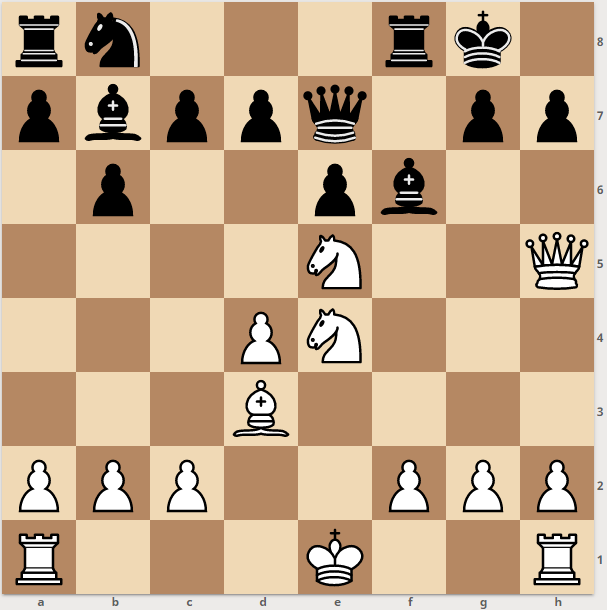
11. Qxh7+ Kxh7 12. Nxf6+ Kh6 13. Neg4+ Kg5 14. h4+ Kf4 15. g3+ Kf3
16. Be2+ Kg2 17. Rh2+ Kg1 18. Kd2.

Checkmate.
GM Nick de Firmian's Column
An Opening for fun and profit: The Smith-Morra Gambit - 1. e4 c5 2. d4
Many gambits of the romantic era of chess in the nineteenth century are regarded as fun and action packed, where the protagonist (usually White) boldly sacrifices a pawn or two and for attacking prospects, an open game and quick clashes right out of the opening. The more scientific era of twentieth century chess saw the rise of accurate defense and put a damper on many of these gambits as the opening theory developed solid responses which side-stepped the risks and brought the defended (usually Black) a solid position and good middle game prospects.
The Smith-Morra Gambit 1. e4 c5 2. d4 exc4 3. c3 was first championed by Pierre Morra of France in the first half of the twentieth century, yet waited until the 1970s to become popular when Ken Smith of Texas wrote a book and worked tirelessly to promote his pet opening. Smith was “only” a master and didn’t get validation from the world’s top players. Famous grandmaster Bent Larsen once annotated a game of Smith’s where his opponent replied to 1. e4 with 1…e5 and Larsen gave that move a question mark, writing “a mistake against Ken Smith as 1…c5! Is know to just win a pawn against him.”
Nonetheless the Smith-Morra gained followers, and Marc Esserman’s superb book several years ago “Mayhem in the Morra” showed many powerful ideas for the white side and rejuvenated the opening. It does what gambits are supposed to do – give you development, open lines and pressure against the opponent. The Smith-Morra can be recommended against the Sicilian for active, attacking players. It has become established as a very promising opening at any level in quick play games, and thus we give those below. In club play and non-grandmaster games it is good at any time control.
(1) Mikhailovsky,Vladimir (2228) - Caruana,Fabiano (2835) [B21]
Titled Tuesday 30th June chess.com INT (2), 30.06.2020
So you are playing the great Fabiano Caruana, and he plays the Sicilian against you. Those who think the Smith-Morra is only an opening to confuse lower rated opponents must think again. See how much trouble the world #2 gets into with Black. 1.e4 c5 2.d4 cxd4 3.c3 dxc3 4.Nxc3 e6 5.Nf3 a6 6.Bc4 The white-squared bishop always develops to this square. It may look a little strange with the black pawns on the light squares, but this works best for the whole system. 6...b5 7.Bb3 Bb7 8.0-0 Be7 [8...b4 9.Nd5! exd5 10.Re1 is fulll compensation for the sacrificed piece. White's open lines and lead in development compensate, e.g. 10...Be7 11.exd5 d6 12.Nd4 Kf8 13.Bf4 Nd7 14.Nf5 Ne5 15.Bxe5 dxe5 16.d6 Bf6 17.Rc1 is a winning attack] 9.Re1 d6 10.Bf4N [Also possible is 10.Nd4 Bf6? 11.Bxe6! fxe6 12.Nxe6 Qd7 13.Nd5 Kf7 14.Nec7 Ne7 15.Nxa8 Nxd5 16.exd5 Bxa8 17.Bg5 Qf5 18.Bxf6 gxf6 19.Rc1 Bxd5 20.Rc7+ Kf8 21.Qe2 Qe5 22.Rc8+ Kg7 23.Qg4+ Qg5 24.Re7+ Bf7 25.Qxg5+ fxg5 26.Rxh8 Nc6 27.Rxh7+ Kxh7 28.Rxf7+ Kg6 29.Rd7 1-0 (29) Moura,E (2130)-Hoshino,K (1949) Sao Paulo 2019] 10...g5?! Fabiano gets aggressive, but this weakens the kingside. [10...Nf6 11.Ng5 Qd7 would be double-eged] 11.Bg3 [11.Be3] 11...h5 12.h3 g4?! 13.hxg4 [13.Nd4! immediately would be good] 13...hxg4 14.Nd4 Nf6?!
 |
 |
(2) Postny,E. (2600) - Abdusattorov,Nodirbek (2627) [B21]
PNWCC Online Blitz JP 16 lichess.org INT (6), 11.07.2020
1.e4 c5 2.d4 cxd4 3.c3 dxc3 4.Nxc3 d6 5.Nf3 e6 6.Bc4 Nc6 7.0-0 Nge7 8.Bf4 Ng6 9.Bg3 a6 10.Qe2 Be7 11.Rfd1 0-0 12.Rac1
 |
 |
(3) Postny,E. (2600) - Niemann,Hans Moke (2465) [B21]
Titled Tuesday 23rd June chess.com INT (4), 23.06.2020
Here Postny meets Hans Niemann, who spent a great deal of time in the Mechanics' Institute and had many battles with our best players in the TNM. 1.e4 c5 2.d4 cxd4 3.c3 dxc3 4.Nxc3 Nc6 5.Nf3 e6 6.Bf4 a6 7.Be2!? Nge7 8.h4 Many players are now using the h-pawn in the Smith-Morra to gain play on the kingside. Of course it weakens the white kingside a bit, but the h-pawn will also cause Black trouble. 8...Ng6 9.Bg3 d6 10.0-0 Be7 11.h5 Nge5 12.h6 gxh6 13.Nh2 Rg8 14.Bh5 Bd7 15.Kh1 Qa5 16.a3 Rc8 17.Bf4 objectivley Black is doing quite well out of the opening. 7. Be2 and 8. h4 is experimental and confusing, but not as principled as the usual Smith-Morra play. 17...Ng6 18.Bxg6 hxg6 19.Bxd6 Bxd6 20.Qxd6 Qc7 21.Qd2 h5 22.f4 Kf8?! Hans has played the game well thus far (of course he learned here at the Mechanics'). His king is in the center but the extra pawn would count after an active move such as [22...Na5! 23.Rad1 Nc4 24.Qe2 Qb6] 23.f5 Now White has active play typical of the opening. 23...exf5? capturing the wrong way. Black could maintain equality with [23...gxf5 24.exf5 exf5 25.Qh6+ Rg7!] 24.Qh6+ Rg7 25.Nd5 The white knights jump into action with decisive effect. 25...Qe5?! 26.Nf3 Qd6 27.Rad1 All the white pieces come into play with threats. There is no defense. 27...Kg8 28.Nb6 Qc7 29.Nxd7 Qd8 30.exf5 Rh7 31.Qf4 Qe7 32.Rfe1 Qd8 33.fxg6 1-0
(4) Lintchevski,D. (2559) - Vitiugov,N. (2722) [B22]
PNWCC Masters WOO 2020 chess.com INT (7.8), 06.07.2020
1.e4 c5 2.d4 cxd4 3.c3 Nf6 4.e5 Nd5 5.Nf3 e6
 |
We give this game as an alternate choice by players of the Black side. You don't have to accept a gambit (almost any gambit). If you don't wish a wild position and like things under control this it is best to decline the Smith-Morra as Vitiugov does here. He thought he was the better player and didn't want an opening battle or a crazy position. This method may suit you as Black. 6.cxd4 This move is the most usual and transposes into a 2. c3 Sicilian. That is fine but Smith-Morra players may prefer 6. Qxd4 Nc6 7. Qe4 which is the line recommended by Smith in the 1970s. 6...d6 7.Bc4 Nb6 8.Bd3 Nc6 9.Qe2 Nb4 10.Bb5+ Bd7 11.0-0 N4d5 12.Bd3 Nb4 13.Bb5 Be7 14.exd6 Bxd6 15.Nc3 We have a "normal" position with equal chances. This type of isolated queen pawn position could arise out of several openings. Here the players just play their game. Vitiugov ended up winning a long endgame after grinding his opponent down. If you like this kind of play then the Smith-Morra declined with 3...Nf6 is for you. 0-1
Submit your piece or feedback
We would welcome any feedback, articles or "Letter to the Editor" piece. Submit yours today through this Google Form:
https://forms.gle/eLfUyg2yFZ3vxgcMA
You can browse through our archived newsletters using the "next" and "previous buttons".
Want to save this newsletter for reading at a later time? Click here to learn how.
Want to be notified when the next newsletter is published? Join Our Email List →
